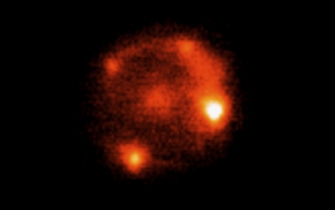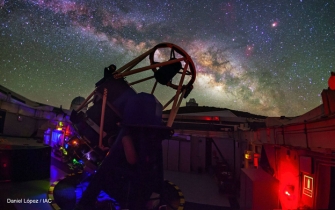
Image: NGC 2264, "Cone" nebula Credit: Georg Suturin
2016
30 AugustA rare supernova challenges astronomers' understanding of the most energetic explosions in the universe
An international team of astronomers have discovered an extremely powerful supernova that doesn’t quite fit any of the proposed models that explain such spectacular cosmic blasts.
When it comes to detonations, supernovae have, until recently, been the champions in the Universe. However, almost two decades ago astronomers started to encounter transient objects, tucked in faint galaxies that were up to 100 times brighter than most supernovae. Dubbed “superluminous supernovae” (SLSN), these extraordinarily energetic events, which can shine brighter than the entire Milky Way galaxy presented a new puzzle to theorists and observational astronomers who have since been trying to understand the mechanisms and physical processes that govern them. A small, but growing sample of SLSN detections has helped advance our knowledge about these celestial behemoths with several theoretical models emerging as winners while many others were ruled out. Yet, the more data an international team of astronomers gathered for PS1-14bj - a superluminous supernova first found in the Pan-STARRS1 Medium Deep Survey - the more obvious it was that this “supernova misfit” challenges much of what we have discovered so far.
The team observed PS1-14bj with several telescopes around the world for approximately two years to obtain sufficient image and spectroscopic data to analyze its evolution in detail. They found that the time between the explosion of the star and the moment the visible radiation from the explosion reached its maximum levels (known as peak luminosity) fits well with predictions made for a class of supernovae known as “pair-instability” supernovae. The latter result from the explosion of gigantic stars on the order of 150 to 250 times more massive than our Sun. The core temperature of these stars is so high it is sufficient to trigger a chain of processes that ultimately result in a spectacular detonation and ejection of the entire material into the interstellar space.
What initially stuck our attention was how slowly this supernova was evolving. It continued to brighten for more than four months after its discovery, before finally starting to fade away. This got us very excited because such long rise-times are a key prediction for a pair-instability explosion, but had never been observed before.
said Dr. Ragnhild Lunnan, a postdoctoral fellow at Caltech currently working for the GROWTH project and a lead author of the study to be published soon in the Astrophysical Journal.
Further analysis however, slowly exposed the peculiar individuality of PS1-14bj. It faded away slowly over more than 250 days without changing its temperature much, suggesting that there is a constant source of heating over very long timescales. This is completely at odds with theoretical predictions and observations of other “pair-instability” superluminous supernovae. Moreover, the observed spectrum over time displayed none of the trends of other proposed models that try to explain how superluminous supernovae are powered, which suggest either a fast spinning neutron stars or a shock wave interaction with the medium surrounding the exploding star.
“Superluminous supernovae are intrinsically very rare, so we are only beginning to find the oddballs like PS1-14bj.” - added Dr. Lunnan. “With upcoming surveys like ZTF, GROWTH and ultimately LSST we should discover dozens of SLSNe which will help us better understand unique objects like PS1-14bj and the physics powering them.”
More Information
What is GROWTH?
What is LSST?
What is Zwicky Transient Facility?
Press coverage of the paper in Phys.org
Conversation
about superluminous supernovae between Dr. Robert Quimby (SDSU), a co-investigator in the GROWTH project with the editor in chief of Sky & Telescope Robert Naeye back in 2011. Robert
Quimby was then a postdoctoral fellow at Caltech.
Contact
Iva Kostadinova
Communications and Media Contact
ivonata@caltech.edu
+1 626 395 2952




